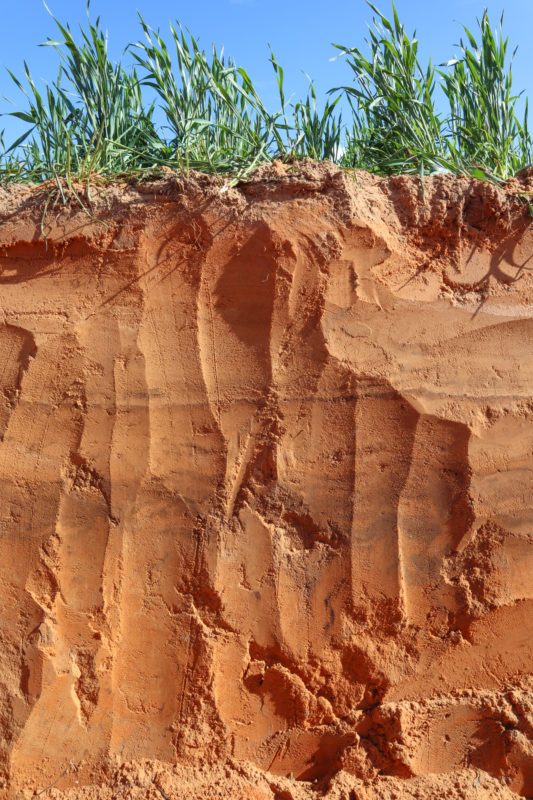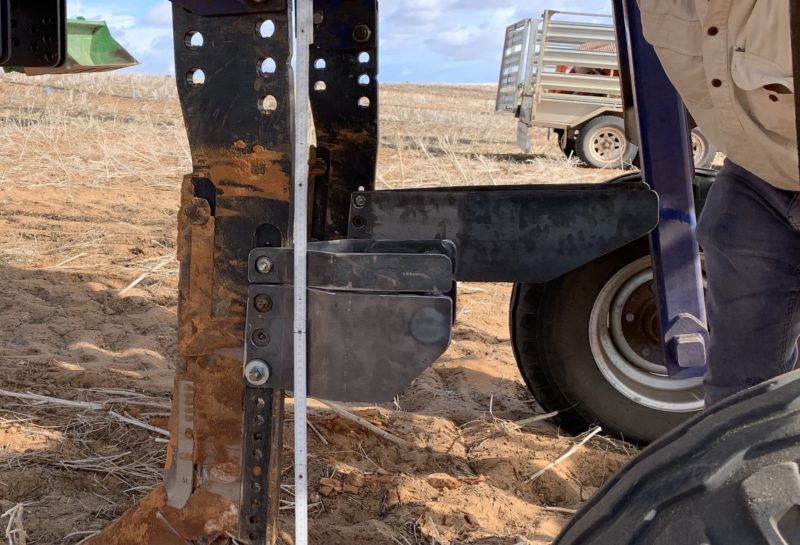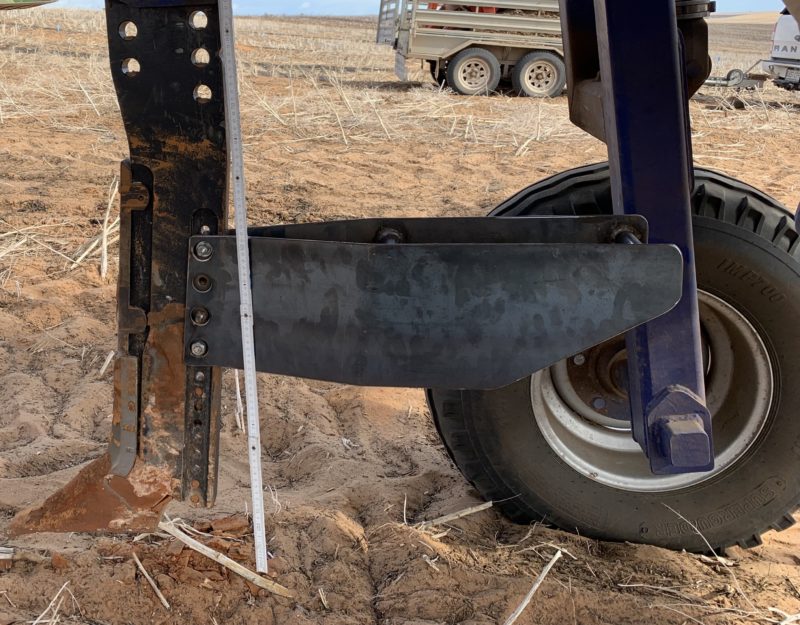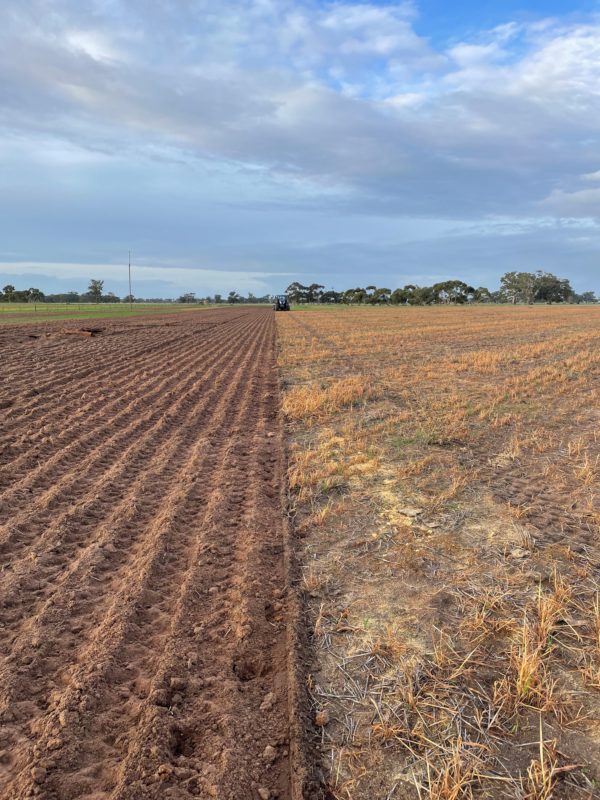Increasing production on sandy soils in low and medium rainfall areas of the Southern Region
The project is looking at why there is unused soil water at harvest in cropping systems on sandy soils, and what are the mitigation and amelioration options to improve this situation. The project is investigating the physical, chemical impediments and the biological constraints in sandy soils and crop establishment on non-wetting soils.
On upper EP, 3 local replicated validation trials and 3 farmer demonstrations sites.
Replicated Validation trials: 2 in 2019, 1 in 2020
Demonstration sites: 1 in 2018, 2 in 2019
The project was extended until March 2023 with additional trials and demonstrations.
On lower EP, 2 replicated validation trails, 2 larger scale demonstration trials, and 4 associated field walks.
SANDY SOILS PROJECT SUMMARY
Fine-tuning sandy soil constraint management
The sandy soils that cover about three million hectares in southeastern Australia have a variety of constraints including water repellence, compaction, hardsetting soil, acidity, alkalinity, and low fertility. These soil constraints can occur individually or in a range of combinations and at different depths, limiting crop root growth, water use and overall productivity. Every situation requires a specific management approach.
The project
Sixteen demonstration sites across South Australia and Victoria are showcasing amelioration techniques that growers can use to address the specific sandy soil constraints in their landscape, and where in the landscape different tactics are best deployed.
Farmers are implementing the trials on their property, ensuring that the recommended techniques can be effectively put into practice. The project team are monitoring the sites to quantify the impact of practices on soil condition, crop productivity and farm profitability.
Eyre Peninsula
AIR EP have contracted PIRSA to monitor these sites. Six trials on the Eyre Peninsula are addressing how deep tillage and adding manures or other organic material can deal with compaction, non-wetting, and poor nutrition.
The four trials in 2022 (Mt Damper, Streaky Bay, Arno Bay and Minnipa) largely used a mix of deep ripping and/or spading, and a variety of mineral and organic fertiliser treatments.
Mt Damper was ripped and spaded in 2019. The trial at this site continued monitoring and applied additional nutrients to meet the increased production potential from ameliorating constraints.
The trials at Streaky Bay and Arno Bay focussed on carbon-based nutrition and companion planting as a potential way to reduce reliance on expensive mineral fertilisers.
This year (2023), trials at Kielpa and Kyancutta are comparing various ripping machines to alleviate compaction and high soil strength. The trials at Kielpa are also demonstrating how various ripping machines can both alleviate compaction and incorporate lime to address sub-surface acidity.
Yorke Peninsula
Northern Sustainable Soils has contracted Trengove Consulting to monitor these sites.
Should I rip, use inclusion plates, or spade to incorporate lime? Can I use these techniques to incorporate organic matter too? These are just some of the questions farmers face when deciding how to deal with subsoil acidity, water repellence, and low soil organic carbon.
On three sites with varying degrees of compaction, soil texture change with depth, acidity and water repellence, this trial is testing a variety of:
- ripping depths (0, 20, 40, 60cm)
- amelioration practices (normal ripping, short inclusion plates, long inclusion plates, spading), and
- chicken litter incorporation practices (as above, and by placing the litter at depth).
The sites are located in a dune swale landscape. One site is situated at the top of the dune on a productive sand over sandy clay loam. The other two sites are on mid-slopes on less productive deep sands. The whole trial site was spread with 5 t/ha lime before ameliorating.

Image 1. Loamy sand soil profile at Bute, SA. Photo: Trengove Consulting.


Image 2. Deep ripper tine with short (250 mm) inclusion plates (left) and long (600 mm) inclusion plates (right). Photo: Trengove Consulting.
Victoria and eastern South Australia
Mallee Sustainable Farming has contracted Frontier Farming to monitor these sites.
These trials cover all the common sandy soil constraints – non-wetting, compaction, hardsetting, low fertility, and acidity. Deep ripping features in five of the six demonstrations as a way to break up compaction and partially incorporate amendments such as manure and lime. The trial at Cowangie, Victoria, is testing one-pass spade-and-sow and plough-and-sow practices for faster crop establishment on non-wetting soil.
| Site | Issue | Strategies |
| Cowangie, Vic (2022) | Non-wetting | One pass spade and sow vs plough and sow for faster crop establishment |
| Kooloonong, Vic (2022) | Compaction | Different deep ripping timings and depths from the top of a sand dune to the swale |
| Younghusband, SA (2022) | Low fertility | Various soil amelioration options including deep ripping with and without inclusion plates, spading, and incorporating chicken litter compost |
| Yappeet, Vic (2023) | Non wetting and hard setting sandy soils | Deep ripping with and without inclusion plates, spading |
| Chinkapook, Vic (2023) | Low fertility, hard setting sandy soils | Deep ripping, various nitrogen fertiliser rates and organic matter inputs |
| Pinaroo, SA (2023) | Acidity | Deep ripping, spading, lime application |
Limestone Coast
MacKillop Farm Management Group has contracted Soil Function Consulting to monitor these sites.
Taking a slightly different approach are two demonstrations on the Limestone Coast, in the higher rainfall areas around Naracoorte. There is a long history of soil amelioration in this region, but what is less well understood is if soil amelioration is profitable in a grazing situation.
A long-term rotational grazing property near Frances, SA, suffers from compaction, subsurface acidity, and a mildly sodic subsoil. The trial at this site is testing how well spading incorporates topdressed lime and changes soil chemistry to improve permanent pasture and productivity. The paddock has been spaded, leaving two un-spaded strips four metres wide right through the paddock.
The second site near Penola is a mix of dryland and irrigated cropping along with dryland pasture production for grazing both cattle and sheep. Acidity, water repellence, and trace element deficiency are major constraints. This site has been delved, bringing alkaline clay to the surface, which was then busted up with railway irons and incorporated with offset discs.
This should serve multiple purposes:
- the alkaline clay neutralising some of the soil acidity
- delving breaking up compaction
- the higher clay content at the surface reduce water repellence
- more clay incorporated throughout the profile boosting soil fertility.
Project manager Mel Fraser had hoped to spade after delving for better incorporation, but the weather did not co-operate, the soil being too wet to spade.

Image 3. Single pass of the Imants spader with deep rip tines fitted, showing small clumps of clay that have been brough to the surface through the ripping/spading operation and a uniform seedbed that is ready for sowing (left), and the unamended soil (right). Photo: Mel Fraser.
Partners This project is led by Agricultural Innovation & Research Eyre Peninsula (AIR EP) and delivered by a team of grower groups and agronomists including Frontier Farming Systems, MacKillop Farm Management Group, Mallee Sustainable Farming, Northern Sustainable Soils, PIRSA, Soil Function Consulting and Trengove Consulting, with support from University of SA’s Agricultural Machinery Research & Design Centre (AMDRC) and CSIRO.
Funding The project funded by the Australian Government’s Future Drought Fund’s Drought Resilient Soils and Landscapes grant program and the Grain Research & Development Corporation, with support from the SA Drought Resilience and Adoption Hub.
Useful resources:
The project has produced a series of fact sheets.
EPFS Articles
Share this project:
You Might Also Like
Retaining soil water in farming systems using strip & disc machinery 2024
This project would enable one demonstration site to be conducted in low rainfall farming systems at Buckleboo to enable extension of past EP demonstration site results and results from other…
Learn MoreFurther tactics to minimise frost damage on the Eyre Peninsula
Previous frost work on the EP has been well received and has assisted in filling key agronomic knowledge gaps around frost mitigation in crop, however, it has been identified that…
Learn MoreSilicon: a novel solution to reduce water use and pest damage in wheat
Quantify how silicon fertilisation increases water use efficiency and pest resistance in wheat at the field scale with agronomic practices in place, including farm settings with contrasting agricultural landscapes.…
Learn MoreA needs analysis for the barriers to adoption of strip and disc systems on Eyre Peninsula
Identify the risks and opportunities (including a cost benefit analysis) faced by growers using Strip and Disc systems to determine any gaps in knowledge to be addressed for this practice…
Learn MoreDelivery of the Sustainable Agriculture Facilitator (SAF)
The Sustainable Agriculture Facilitator (SAF) is a designated central contact point for farmers, landholders, industry, and community groups and will aim to support sustainable agriculture practices in Eyre Peninsula. The…
Learn MoreVirtual Fencing for improved climate resilience on South Australian farms
This project will continue the work of initial trials to look at the use of virtual fencing technology in a new field site on the Eyre Peninsula to look at…
Learn MoreSA Young Farmer – Facilitated Peer to Peer Learning
To share innovative ways to build drought resilience and build local leadership, networks, and social support In Ceduna and Cleve locations AIR EP will offer four field events for young…
Learn MoreSA Eyre Peninsula Coordination FRRR Community Impacts Grants
To strengthen drought preparedness and drive local action in the Eyre Peninsula region through the coordination of Community Impact Program activities and evaluation administration. Bi-monthly meetings between key delivery partners,…
Learn MoreImproving the climate resilience of the Australian Sheep Flock
Project activities include • Demonstration of practical strategies which improve the fertility of sheep joined during summer • Collation and communication of results from management trials • Demonstration of the…
Learn MoreBuilding farming systems resilience and future proofing the impacts of drought through accelerating the adoption of proven cost-effective and yield responsive soil and fertiliser management practices by farmers across southern Australia
The project focuses on accelerating adoption of proven soil resource management practices offering significant opportunity to build farming systems drought resilience, reduce yield variability, increase sustainability and profitability. These practices…
Learn More